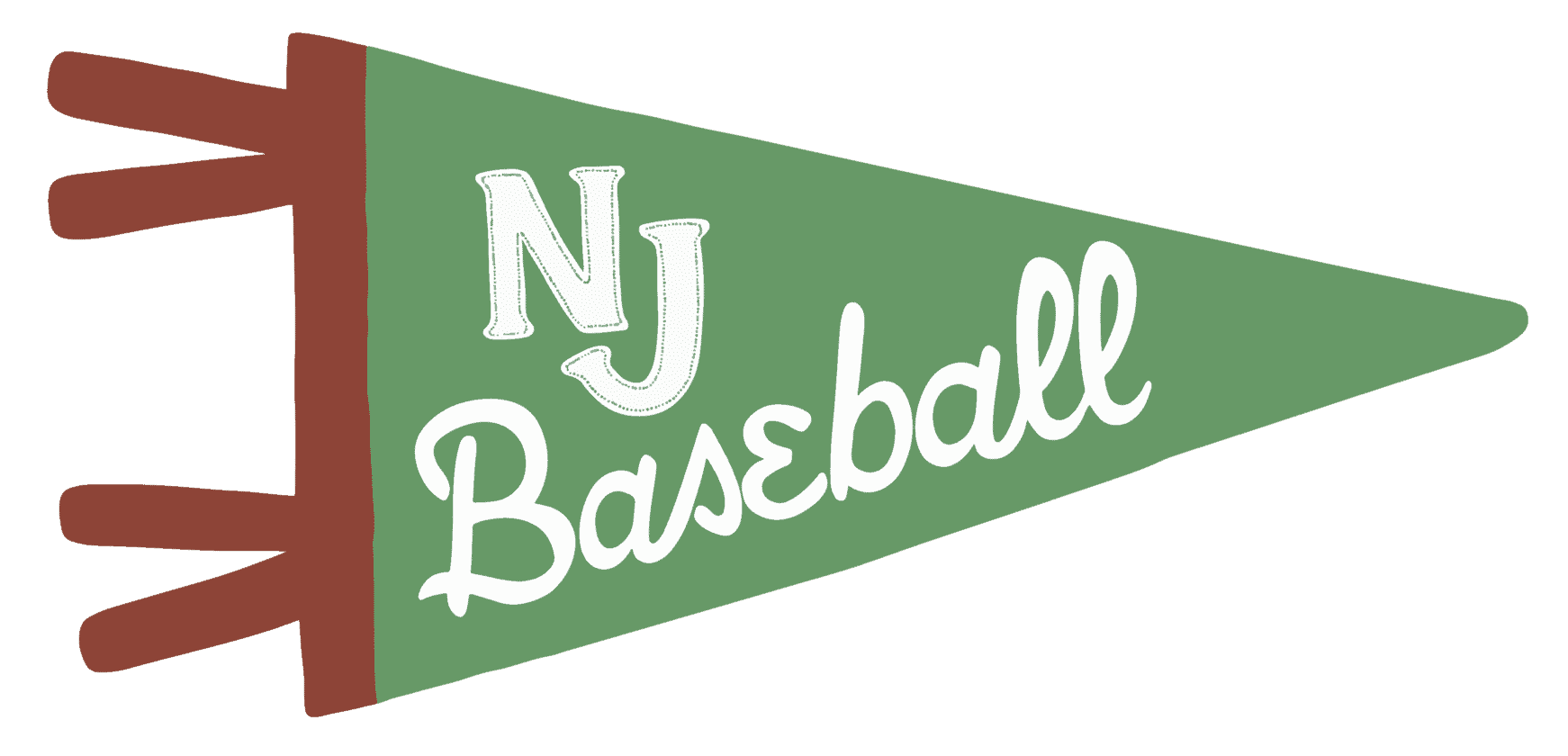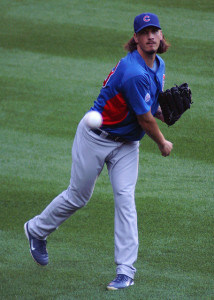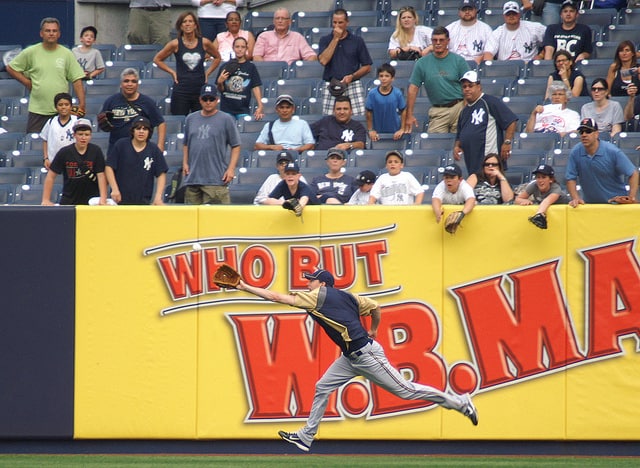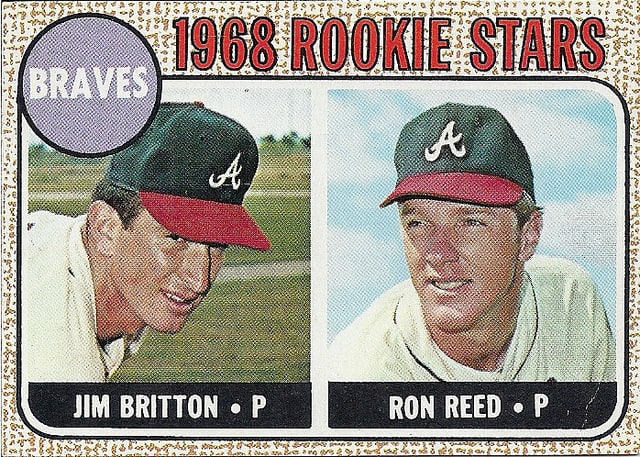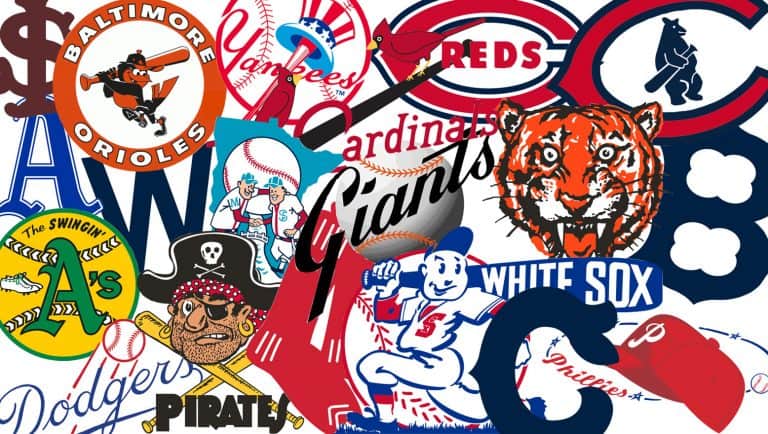From ND to MLB: Jeff Samardzija
I’ve fallen way behind on my Notre Dame to MLB project, so it’s time to pick it up again. In an effort to move things along, I’m going to do something I don’t generally like to do — post a Q&A or two. It’s just a personal thing. I don’t do that much writing anymore, unless it’s on this blog, so I like to weave the comments I get into stories rather than simply posting a transcript. But those long-form explorations of a player’s history can take time, especially when I delve deeply into the past — his early years, his time at Notre Dame, his signing with a team and the climb through the minors. And I’d like to get back to some of that with the older, more obscure players, those who have been forgotten — or were never really known in the first place.
 These next three, all of whom are still active, have come up in the digital age, so their histories are a bit more known. There’s not much to uncover there. But I’ll still look back a little before getting into the questions and answers. First up: Jeff Samardzija.
These next three, all of whom are still active, have come up in the digital age, so their histories are a bit more known. There’s not much to uncover there. But I’ll still look back a little before getting into the questions and answers. First up: Jeff Samardzija.
Samardzija, as pretty much everyone knows, made his name on the Irish football team, specifically in 2005 and ’06 under Charlie Weis. During those two seasons, he established new school records for single-season receptions and yards and in three seasons on the gridiron set all three primary career marks: receptions, yards and touchdowns. His 15 TDs in 2005 remain the single-season record, tied in 2009 by Golden Tate (also an Irish baseball player, drafted by the Giants that year in the 50th round, but now a receiver with the Seattle Seahawks). Michael Floyd has since surpassed all of Samardzija’s career marks.
As a receiver, Samardzija made some amazing and memorable plays, two of which stand out above all others for me. The first was a spectacular one-handed diving catch on a long pass at Purdue in 2005. I recall watching that from the 21st Amendment brewpub in San Francisco while on my honeymoon (thanks to my wife picking the place for pregame drinks the previous night, when we went to a Diamondbacks-Giants game).
The second was his thrilling catch-and-run to beat UCLA in 2006. I was at this game, sitting with a Bruin grad (the friend and business partner of a Notre Dame friend) in the corner of the north end zone above the student section. We watched as Samardzija took Brady Quinn’s pass and dodged and weaved his way into the south end zone for the winning score. Don Criqui’s radio call is outstanding:
On the diamond, Samardzija didn’t have any heart-pounding plays like that, but he made an impact beginning in his freshman year, going 5-3 with a 2.95 ERA in 20 games (six starts). He held opposing hitters to a .209 average, easily his best mark for the Irish. In his sophomore season, he started 10 of the 15 games in which he appeared, and by his junior year he was a full-time starter.
| Year | ERA | W | L | G | GS | CG | SHO | SV | IP | H | R | ER | BB | SO | 2B | 3B | HR | BF | Avg. | WP | HBP | SFA | SHA |
| 2004 | 2.95 | 5 | 3 | 20 | 6 | 0 | 0 | 1 | 64 | 50 | 25 | 21 | 17 | 42 | 2 | 1 | 5 | 0 | 0.209 | 3 | 3 | 0 | 3 |
| 2005 | 3.89 | 8 | 1 | 15 | 10 | 1 | 0 | 0 | 78.2 | 85 | 39 | 34 | 30 | 56 | 10 | 3 | 3 | 360 | 0.272 | 3 | 10 | 1 | 6 |
| 2006 | 4.33 | 8 | 2 | 15 | 15 | 0 | 0 | 0 | 97.2 | 101 | 51 | 47 | 37 | 61 | 24 | 2 | 3 | 426 | 0.272 | 5 | 5 | 3 | 10 |
| Total | 3.82 | 21 | 6 | 50 | 31 | 1 | 0 | 1 | 240.1 | 236 | 115 | 102 | 84 | 159 | 36 | 6 | 11 | 786 | 0.256 | 11 | 18 | 4 | 19 |
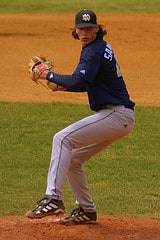 After that 2006 season, the Cubs selected Samardzija in the fifth round of the draft. He signed and reported to their short-season Boise affiliate. Before the summer was out, he earned a promotion to Peoria, then returned to campus in August for football camp. After his senior football season and a 2007 Sugar Bowl appearance, speculation began as to whether Samardzija would try to play both baseball and football professionally. He was considered a mid-to-late first-round pick in the NFL, but he didn’t stick around long enough to find out. In late January 2007, he signed a five-year deal with the Cubs.
After that 2006 season, the Cubs selected Samardzija in the fifth round of the draft. He signed and reported to their short-season Boise affiliate. Before the summer was out, he earned a promotion to Peoria, then returned to campus in August for football camp. After his senior football season and a 2007 Sugar Bowl appearance, speculation began as to whether Samardzija would try to play both baseball and football professionally. He was considered a mid-to-late first-round pick in the NFL, but he didn’t stick around long enough to find out. In late January 2007, he signed a five-year deal with the Cubs.
Samardzija spent just one full season in the minors in 2007, going 6-11 with a 4.57 ERA between high Class A Daytona and Double-A Tennessee. He spent 2008 split three ways: 16 games at Double-A, six games at Triple-A Iowa and 26 in the bullpen for the Chicago Cubs, debuting on July 25, 2008, pitching two innings in relief of Ryan Dempster at Wrigley Field. Another split season in 2009 saw Samardzija wearing an Iowa cap for 18 games (17 starts) and a Cubs lid for 20, though two of those were his first starts in the Major Leagues. In 2010, however, he saw action in only seven Major League games — starting three and compiling a 2-2 record, though with an 8.38 ERA. He appeared in 35 games for Iowa in 2010, starting 15, and going 11-3 with a 4.37 ERA.
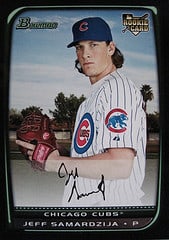 The 2011 season was Samardzija’s first spent entirely on the big-league roster and it resulted in career bests nearly across the board: 75 games, 88 innings, 8-4 record, 2.97 ERA, 1.30 WHIP, 87 strikeouts, etc. In fact, the only stat in which he did not set a new career mark was home runs allowed — yielding just five, compared to seven in 20 games in ’09.
The 2011 season was Samardzija’s first spent entirely on the big-league roster and it resulted in career bests nearly across the board: 75 games, 88 innings, 8-4 record, 2.97 ERA, 1.30 WHIP, 87 strikeouts, etc. In fact, the only stat in which he did not set a new career mark was home runs allowed — yielding just five, compared to seven in 20 games in ’09.
As the Cubs head into the 2012 season — pitchers and catchers report to Mesa, Ariz., on Saturday — Samardzija will be stretched out to compete for a rotation spot, though at the moment it looks like he’d be eighth (at best) in the pecking order. Barring an injury or a dominating spring, I’d expect Shark to return to the bullpen as the top setup man — and sometimes closer — for Carlos Marmol. And should Marmol be traded, Samardzija could become Chicago’s stopper.



So here’s our conversation from last September, when the Cubs were in New York to play the Mets. We spent a few minutes after this discussing the current state of Notre Dame football, but since that’s now both dated and not related to Samardzija’s ascension from Eck Stadium to Wrigley Field, I didn’t bother to post it.
Did you follow the Irish before you got there?
Yeah, we always kept our eye on them. Became a little more in touch with what was going on over there when they started making their runs in the [NCAA] playoffs, and then my senior year in high school they went to the [College] World Series. I went to some camps over there when I was a kid. I went back and forth. [Valparaiso University] was right there in my back yard. We kind of went back and forth with ND and there, watching baseball and football and so on.
What was it about ND that drew you in?
My decision to go to ND was based more professionally, based on being a student and where I was going to go after my college career. My dad always told me growing up, “You never know what’s going to happen on the field.” Playing sports is a crazy business — college, pro, high school — you just never know what’s going to happen. My dad instilled in me early to make a decision based on what I was going to do for a job, pretty plain and simple. And then everything I ever heard about Notre Dame was, you go there, when you leave, you’re gonna be in a good situation to have a good life and take care of your family. But fortunately, things worked out the other way and I didn’t have to use my degree [in business marketing] too much yet. But hopefully down the road.
What’s it like playing baseball there, opposed to football.
It’s totally different. Football, you get the silver spoon. Baseball at ND, I don’t want to say the bronze spoon — they get a nice spoon, but it’s not as good as the football one. [Laughs.] It’s totally different, you’re under the radar a little bit more in baseball. You’re just kind of playing your sport, you get some fans — 2,000, 2,500 people — so it’s more intimate. It’s a good situation. Football’s just so blown up there. Every move is watched, every player is watched. It was almost nice for me to go from football into the spring, summer, and play baseball and kind of unwind. Baseball’s always been a good release for me, helps me get away from things.
What do you remember about draft day?
It was awesome. It was pretty much all I could ask for. I was a White Sox/Cubs guy growing up. I was a Cubs fan, but we could [better] afford tickets to White Sox games, they were like nine bucks. I’ve always loved Chicago. Been a big Bears, Blackhawks fan my whole life. To be able to stick around the city and have that weigh into my decision was huge. Sometimes things fall into place, man. It was kind of funny.
In baseball, nearly all players have an apprenticeship in the minors, whereas in football, you’d go straight to the NFL after being drafted. Did that play into your thoughts at all?
I don’t think I ever let myself believe I was going to be in the minor leagues for too long. [Laughs.] I’m not saying that that’s the truth or that was going to happen, but I guess I just had my eyes on the big prize and where I wanted to end up. Looking back on it, maybe I should’ve spent some more time in the minor leagues. But that’s alright, I guess you just cut your teeth whenever you get a chance to in the Major Leagues.
What memories do you have from the minors?
I remember being in Daytona, and I was not having a very good season at all, by any means. But I still remember being down there and wanting to be there, you know? And that was a year out of playing football. To realize I was there and having fun, really enjoying what I was doing, baseball-wise, and getting better. Again, I was looking at the big picture and where I wanted to be, in Chicago. To me, that meant a lot to me to not sit there and just loathe over not playing football. That’s how I knew — little situations like that help you realize that you made the right decision, that you did the right thing.
Other than that, the minor leagues are fun, dude. With the bus trips, it’s like you’re kind of still in college, in a way. In the minor leagues, you learn to grow up, how to balance everything and have an everyday life with baseball.
What do you remember about your MLB debut?
I remember it was against the Marlins. Struck out the first guy I saw. [Alfredo] Amezega, I believe. Threw two innings, I think. It was cool. It was cool for me to come up and get called up by Lou [Piniella], have my first experience under Lou, first half-season under Lou. It was something I think that will be with me for a long time. He’s a very interesting guy, to say the least. It’ll be a good story down the road.
Do you still follow the Irish?
I’m a little different, man. I watch [football], but it’s hard for me to watch. I played there, so I kind of know what’s going on, but it’s hard for me to communicate with other people about it because they base their opinions on what they see. But ND has a lot of things going on that people don’t know about. There’s a lot of alumni and a lot of outside influence. I watch, but I take it with a grain of salt. I try to do it just more for entertainment than trying to break it down and scout our own team. I had my fun while I was there, and now I’m happy to take a deep breath and be able to enjoy watching as a fan.
{NOTE: At this point, Jeff and I started chatting like fellow Notre Dame alumni, not as reporter and athlete, about the football team. It was six days after the Irish opened the season with a loss at home to South Florida and a day before they went to Michigan and lost on the final play of the game. After this question about John Axford, Jeff then asks me where I lived while on campus and tells me how much he hated my second dorm, O’Neill Hall, because of the memories it brought back about August football training camp. That pretty much wrapped up our conversation.}
I talked to Axford, he said he stops by campus after the season on his drive from Milwaukee to Ontario.
Everybody usually does. I played with Axford two years, had a good time. Ax is a great dude. I never played with [Brad] Lidgey. He was there a little before me.
Where’d you live?
I lived in Grace Hall, then the first year O’Neill was open.
Oh nice, man. New one. O’Neill, summer camp. I walk in that front door, I’ll take a breath in, I’m like … I start twitching. They put up these big tents, dude. Huge tents. These wood floors down, they put up all these chairs there as our lockers, man. It’s hot. You could smell, going from O’Neill into that tent, you could smell that wood. You were just like, “Man, I’m in camp, I know it.” You could be blindfolded and you’d know it. I was in Alumni. I just roasted, dude. And I can’t sleep when I’m hot. I need it cold. Being from the north, I like it when it’s 20 degrees outside and I can put about 10 blankets on. Those windows would be open and I’d have fans just on my face. It’s tough man, it’s tough.
